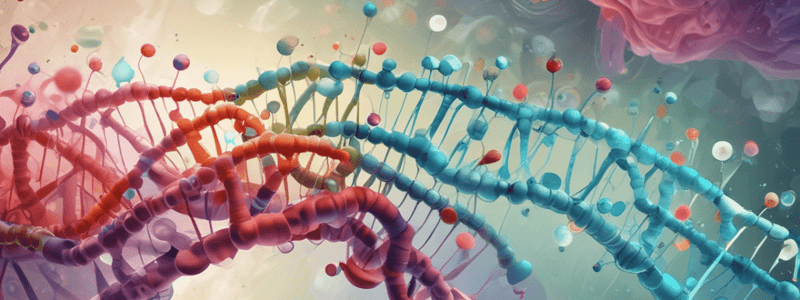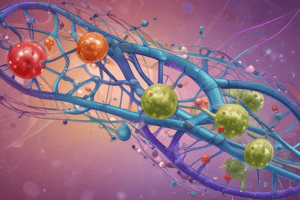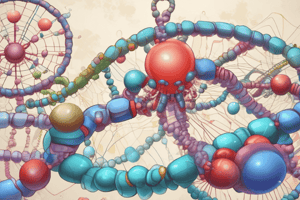Podcast
Questions and Answers
What is the primary function of DNA promoters in eukaryotic cells?
What is the primary function of DNA promoters in eukaryotic cells?
- To bind RNA polymerase II
- To synthesize RNA in vitro
- To provide accurate and efficient initiation of mRNA synthesis (correct)
- To regulate gene expression in prokaryotic cells
What is the common element found in many Pol II promoters?
What is the common element found in many Pol II promoters?
- A/T-rich TATA box (correct)
- C/G-rich sequence
- A/G-rich sequence
- T/G-rich sequence
What is the role of general transcription factors in the regulation of gene expression?
What is the role of general transcription factors in the regulation of gene expression?
- To inhibit gene expression
- To regulate gene expression in prokaryotic cells
- To provide differential gene expression complexity (correct)
- To synthesize RNA in vitro
What is the name of the complex formed by the assembly of general transcription factors and RNA polymerase II on the core promoter elements?
What is the name of the complex formed by the assembly of general transcription factors and RNA polymerase II on the core promoter elements?
What is the function of TFIID in the pre-initiation complex?
What is the function of TFIID in the pre-initiation complex?
What is the difference between the TATA box in eukaryotic cells and the Pribnow Box in prokaryotic cells?
What is the difference between the TATA box in eukaryotic cells and the Pribnow Box in prokaryotic cells?
What is the result of RNA polymerase II synthesizing RNA in vitro in the absence of general transcription factors?
What is the result of RNA polymerase II synthesizing RNA in vitro in the absence of general transcription factors?
What is the purpose of the core promoter element in gene expression?
What is the purpose of the core promoter element in gene expression?
What is the primary function of upstream promoter elements?
What is the primary function of upstream promoter elements?
What is a characteristic of upstream promoter elements?
What is a characteristic of upstream promoter elements?
What is the purpose of inserting putative regulatory gene fragments upstream of the coding region of a reporter enzyme?
What is the purpose of inserting putative regulatory gene fragments upstream of the coding region of a reporter enzyme?
What is a characteristic of transcription factors?
What is a characteristic of transcription factors?
What is the result of deleting DNA elements from the 5’ or 3’ ends?
What is the result of deleting DNA elements from the 5’ or 3’ ends?
What is the role of acidic, glutamine or proline residues in transcription factors?
What is the role of acidic, glutamine or proline residues in transcription factors?
What is the purpose of measuring reporter activity?
What is the purpose of measuring reporter activity?
What is a feature of domain architecture in transcription factors?
What is a feature of domain architecture in transcription factors?
What is the reason for faster DNAseI digestion in actively transcribed genes?
What is the reason for faster DNAseI digestion in actively transcribed genes?
What is the effect of histone acetylation on chromatin structure?
What is the effect of histone acetylation on chromatin structure?
What is the role of histone acetyltransferases (HATs) in gene expression?
What is the role of histone acetyltransferases (HATs) in gene expression?
What is the purpose of using antibodies against transcription factors in chromatin immunoprecipitation (ChIP) assays?
What is the purpose of using antibodies against transcription factors in chromatin immunoprecipitation (ChIP) assays?
What is the function of enhancer and response elements in gene regulation?
What is the function of enhancer and response elements in gene regulation?
What is the characteristic of histones that is affected by acetylation?
What is the characteristic of histones that is affected by acetylation?
What is the role of CBP (CREB-binding protein) in gene expression?
What is the role of CBP (CREB-binding protein) in gene expression?
What is the characteristic of chromatin in actively transcribed genes?
What is the characteristic of chromatin in actively transcribed genes?
What allows enhancers to activate transcription from a large distance?
What allows enhancers to activate transcription from a large distance?
What is a common feature of enhancer sequences?
What is a common feature of enhancer sequences?
How do hormones and second messengers influence gene expression?
How do hormones and second messengers influence gene expression?
What typically occurs when enhancers are located far from promoters?
What typically occurs when enhancers are located far from promoters?
What type of regulatory element responds to cellular stimuli such as heat shock or heavy metals?
What type of regulatory element responds to cellular stimuli such as heat shock or heavy metals?
Which of the following statements about repressors acting at silencers is true?
Which of the following statements about repressors acting at silencers is true?
What is the result of phosphorylation of CREB?
What is the result of phosphorylation of CREB?
What is the role of CBP in gene expression?
What is the role of CBP in gene expression?
What is the characteristic of steroid receptors?
What is the characteristic of steroid receptors?
What is the effect of binding of hormones to their receptors?
What is the effect of binding of hormones to their receptors?
What is the result of activation of steroid receptors?
What is the result of activation of steroid receptors?
What is the gene family that steroid receptors belong to?
What is the gene family that steroid receptors belong to?
What event allows the glucocorticoid receptor (GR) to move into the nucleus?
What event allows the glucocorticoid receptor (GR) to move into the nucleus?
What transcriptional element becomes active upon hormone binding to the glucocorticoid receptor?
What transcriptional element becomes active upon hormone binding to the glucocorticoid receptor?
What aids the process of altering chromatin structure to allow transcription factor access to core promoters?
What aids the process of altering chromatin structure to allow transcription factor access to core promoters?
What is a characteristic feature of many transcription factors, such as those involved in glucocorticoid receptor functioning?
What is a characteristic feature of many transcription factors, such as those involved in glucocorticoid receptor functioning?
Which sequence represents the symmetrical response element found on the strand for the glucocorticoid receptor?
Which sequence represents the symmetrical response element found on the strand for the glucocorticoid receptor?
What is the effect of the activated glucocorticoid receptor on chromatin structure?
What is the effect of the activated glucocorticoid receptor on chromatin structure?
What is the function of tissue-specific transcription factors in gene expression?
What is the function of tissue-specific transcription factors in gene expression?
What is the role of homeotic genes in development?
What is the role of homeotic genes in development?
What is the common feature of homeodomain-containing genes?
What is the common feature of homeodomain-containing genes?
What is the role of MyoD in gene expression?
What is the role of MyoD in gene expression?
What is the characteristic feature of Hox genes?
What is the characteristic feature of Hox genes?
What is the role of Oct2 in gene expression?
What is the role of Oct2 in gene expression?
What is the effect of mutations in homeotic genes?
What is the effect of mutations in homeotic genes?
What is the role of general transcription factors in gene expression?
What is the role of general transcription factors in gene expression?
What is a common feature of transcription factors that act as activators?
What is a common feature of transcription factors that act as activators?
How do repressors typically inhibit transcription?
How do repressors typically inhibit transcription?
In what way can transcription factors contribute to cancer when mutated?
In what way can transcription factors contribute to cancer when mutated?
What is an example of an oncogene that promotes cancer when overexpressed?
What is an example of an oncogene that promotes cancer when overexpressed?
What is the role of p53 in healthy cells?
What is the role of p53 in healthy cells?
What is a characteristic of co-activators in transcription regulation?
What is a characteristic of co-activators in transcription regulation?
Which transcription factor is known as the ‘guardian of the genome’ and often mutated in human tumours?
Which transcription factor is known as the ‘guardian of the genome’ and often mutated in human tumours?
What can be a consequence of having high levels of c-Fos expression?
What can be a consequence of having high levels of c-Fos expression?
Study Notes
Eukaryotic Promoters and Regulatory Sequences
- Eukaryotic promoters are sequences in the vicinity of the transcription start site required for accurate and efficient initiation of mRNA synthesis.
- Regulatory elements include promoter and upstream elements that dictate cell-type specificity and induction by hormones.
- Transcription factors bind to four types of DNA elements: core promoter element, upstream promoter elements, enhancer sequences, and response elements.
Core Promoter Element
- Consensus sequences reveal a common element: the A/T-rich TATA box (5’TATA(A/T)(A/T)A(A/T)3’) centered at –25 bp from the transcription start site.
- The TATA box is present in many but not all Pol II promoters, similar to the prokaryotic Pribnow Box, but further upstream from the start site.
Initiation of Transcription
- RNA polymerase II synthesizes RNA in vitro using NTPs and a DNA template, but initiation is non-specific and uses either strand of the DNA as a template.
- Accurate initiation of transcription is achieved with the aid of the pre-initiation complex (PIC).
Pre-Initiation Complex (PIC)
- The PIC assembles in an ordered fashion upon the core promoter elements, consisting of general transcription factors and RNA polymerase II.
- The PIC only needs the addition of NTPs for transcription initiation.
General Transcription Factors
- General transcription factors include TFIIA, TFIIB, TFIID, TFIIE, TFIIF, and TFIIH.
- TFIID is a complex of TATA binding protein (TBP) and TBP-associated factors (TAFs).
- TBP recognizes the TATA box, determining the start site position and initiating PIC assembly.
- TFIIF binds RNA polymerase II and brings it into the PIC.
- Other basal transcription factors have roles in open complex formation and/or promoter clearance.
Upstream Promoter Elements
- The TATA box is a core promoter element essential for accurate initiation, but it's not sufficient for efficient transcription in vivo.
- DNA elements within the -50 to -150 region are involved in efficient transcription, in addition to the TATA box.
- These elements are generally short (~10bp) DNA sequences that regulate transcription by interacting with transcription factors.
- They don't have a fixed position with respect to the start site and can be present in multiple copies.
Transcription Factors
- Transcription factors (activators or repressors) bind to upstream promoter elements and modulate the basal level of transcription.
- They are sequence-specific DNA-binding proteins with:
- Separate DNA-binding domains that bind upstream promoter elements.
- Activation domains that interact with general transcription factors (GTFs) and/or co-activators/co-repressors.
- They regulate transcription activity and are rich in acidic, glutamine, or proline residues.
Identification of Regulatory Elements
- Experimental evidence for identifying DNA elements involves:
- Inserting putative regulatory gene fragments upstream of the coding region of a reporter enzyme (e.g., firefly luciferase).
- Introducing resulting plasmids into cells by transfection.
- Measuring reporter activity.
- Active regulatory gene fragments can be further subdivided by:
- Restriction digestion.
- Deletions from 5' or 3' ends.
- Mutations to determine precise boundaries.
Assaying DNA-Binding Proteins
- The presence of DNA-binding proteins and their recognition sequences in the DNA can be assayed by:
- DNA foot printing.
- Chromatin immunoprecipitation (ChIP), which determines the binding sites of DNA-binding proteins in cells.
Transcription in Chromatin
- Nucleosomes do not disassemble during transcription, and most promoters are probably nucleosome-free.
- DNAseI digestion occurs faster in actively transcribed genes compared to non-transcribed parts of the DNA, and DNAse I hypersensitive-sites occur in promoter regions.
Histone Modifications
- Histones are subject to various post-translational modifications, including acetylation, methylation, phosphorylation, and ubiquitination.
- Acetylation of histones, specifically the addition of an acetyl group to a free amino group in lysine residues, reduces the net positive charge.
- Acetylated histones are preferentially found in active genes where chromatin is less tightly packed.
Histone Acetylases and Deacetylases
- Histone acetylases (HATs) activate gene expression, while histone deacetylases inhibit gene expression.
- HATs are found as components of the basal transcription machinery and specific activating transcription factors.
- Histone deacetylases are found as components of repressor transcription factors.
- Example: CBP (CREB-binding protein) is a histone acetylase.
Enhancers and Response Elements
- Enhancers and response elements are found upstream, in introns, and/or downstream (in the 3' region of the genome).
- These elements are bound by sequence-specific transcription factors that work together to regulate transcription.
- A typical pol II promoter has a characteristic "patchwork" arrangement of binding site motifs for different sequence-specific transcription factors.
- The precise combination of sites varies from gene to gene.
Transcription Factor Binding Sites
- AP1 and AP2 are DNA elements recognized by the dimeric sequence-specific binding transcription factors c-Fos and c-Jun.
- GRE and CRE are glucorticoid and cAMP response elements, respectively.
- CCAAT and GC are known as the 'CCAAT' box and GC box, respectively.
Enhancer Sequences as Regulatory Elements
- Enhancers are ~100bp long and contain closely spaced transcription factors binding sites
- They can activate transcription from a large distance (many kbp) in either orientation, upstream or downstream of a gene
- Repressors acting at silencers also exist
- Activation or repression by elements far from the promoter might occur by bending of the DNA
Mechanism of Enhancement
- When enhancers are far away from promoters, enhancement of the rate of transcription occurs via DNA bending
- Figure 2.6 illustrates long-range regulatory interactions through DNA bending
Response Elements as Regulatory Elements
- Promoters of some genes are activated in response to certain cellular stimuli, such as: • Heat shock • Heavy metals • Serum • Steroid hormones
- All genes containing these elements will be induced co-ordinately
- Response elements can be located within far-away enhancers or closer to promoters
- Hormones and second messengers couple external stimuli to gene expression by modifying the structure or location of transcription factors that bind these response elements
Regulation of Transcription
- Phosphorylation of CREB (cAMP-response element-binding protein) activates its transcription activity
- Phosphorylated CREB enables the binding of the CBP co-activator factor, which can bind the basal transcription machinery
- CBP (CREB-binding protein) is a histone acetylase that enhances gene expression
Steroid Hormone Receptors
- Steroid hormones, such as sex hormones and adrenal cortical hormones, exert effects on growth, metabolism, and sexual differentiation
- These hormones act by interacting with specific receptor proteins, which are activated upon hormone binding
- Activated receptors bind specific hormone response elements in target genes, thus activating their transcription
- Steroid receptors are crucial physiological, developmental, and medically important transcription factors
- Receptors for steroid hormones, vitamin D, and thyroid hormone have similar overall structures and are part of the steroid-thyroid hormone receptor or nuclear receptor gene superfamily
Activation of Glucocorticoid Receptors
- Activation of glucocorticoid receptors (GR) by cortisol binding involves dissociation of hsp90, receptor dimerization, and movement into the nucleus
- Hormone binding activates a previously inactive transcriptional activator domain in the receptor, allowing it to activate gene expression following DNA binding
- Activated receptors alter chromatin structure, allowing general transcription factors access to core promoter elements
- Binding of histone acetylase co-activators by the activated receptors aids this process
Transcription Factor Structure and Function
- Many transcription factors (TFs) are dimers due to the symmetry of their response elements
- Examples include the glucocorticoid receptor DNA-binding domain in complex with DNA
Tissue-Specific Gene Expression
- Tissue-specific proteins are expressed due to tissue-specific transcription factors synthesized or activated only in one specific tissue.
- Examples of tissue-specific transcription factors include MyoD in myoblasts, controlling muscle-specific genes, and Oct2 in B-cell lymphocytes, regulating light and heavy-immunoglobulin genes.
Developmentally Regulated Transcription Factors
- Homeotic genes (Hox genes) direct the development of individual body parts.
- Mutations in homeotic genes result in transformations, such as antennae transforming into legs in Drosophila melanogaster.
- Homeotic genes encode transcription factors, and homologues have been identified in mammals, sharing the homeodomain that binds specific promoter DNA sequences.
- Mouse Hox genes specify the differences between cells along the main head-to-tail axis.
Eukaryotic Transcription Factors
- Eukaryotic transcription factors can be subdivided into general transcription factors (TFIID, TFIIA, TFIIB, TFIIE, TFIIF, and TFIIH) and RNA polymerase.
- General transcription factors have low, basal activity, sufficient for accurate transcription in vitro.
- Activators stimulate transcription by stabilizing or activating general transcription machinery, while repressors can prevent binding of general transcription factors and/or RNA polymerase to DNA.
Transcription Factor Characteristics
- Transcription factors can be constitutive, inducible, tissue-specific, or developmentally regulated.
- They contain a sequence-specific DNA-binding domain and an activation domain that interacts with general transcription factors.
- Mutations in or altered levels of some transcription factors can result in cancer.
Co-activators and Co-repressors
- Co-activators and co-repressors regulate transcription by interacting with activator or repressor transcription factors through protein-protein interactions.
- Examples include histone acetylases and deacetylases.
Transcription Factors as Oncogenes and Tumor Suppressor Genes
- Mutations in transcription factors can result in altered levels of mRNAs, leading to cancer if the affected mRNAs encode proteins important in cell cycle control or proliferation.
- Oncogenes, when overexpressed, promote cancer, while tumor suppressor genes, when mutated, can lead to cancer.
- Examples of oncogenes include c-fos, which forms a dimer with c-Jun to form AP1, and tumor suppressor genes include p53, which normally acts as a tumor suppressor by activating genes whose products inhibit cellular growth, and WT1.
Studying That Suits You
Use AI to generate personalized quizzes and flashcards to suit your learning preferences.
Description
This quiz covers the concepts of DNA promoters, core promoter, and upstream elements in eukaryotic cells, including their role in initiating mRNA synthesis and regulating gene expression.




